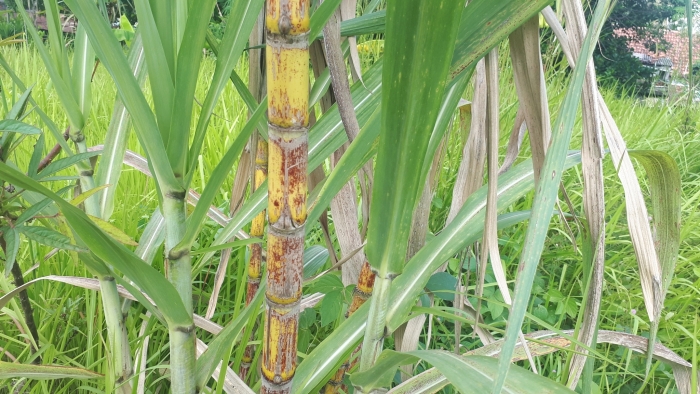Sugarcane
(Saccharum officinarum)
Sugarcane (Saccharum officinarum)
/
/

© Ong Jyh Seng
CC BY-SA 4.0
Image By:
© Ong Jyh Seng
Recorded By:
Copyright:
CC BY-SA 4.0
Copyright Notice:
Photo by: © Ong Jyh Seng | License Type: CC BY-SA 4.0 | License URL: http://creativecommons.org/licenses/by-sa/4.0/ | Uploader: ongzi | Publisher: iNaturalist |

























Estimated Native Range
Summary
Saccharum officinarum, commonly known as sugarcane, is a tall perennial grass native to the tropical regions of South Asia and Southeast Asia, including New Guinea. It typically grows up to 16 feet (5 meters) in height, featuring stout, jointed, fibrous stalks that are rich in sucrose, which accumulates in the stalk internodes. Sugarcane is primarily cultivated in tropical and subtropical regions around the world for sugar production.
Sugarcane’s robust growth and high sugar content make it a valuable crop. It is widely used in the production of sugar, molasses, rum, and ethanol. In the garden, it can serve as a tall, architectural element or as a windbreak in suitable climates. It thrives in full sun and requires ample water, especially during the growing season. Sugarcane prefers fertile, well-drained soils and does not tolerate frost. While it is a commercial crop, it can become invasive outside its native range due to its vigorous growth and ability to spread through rhizomes. Gardeners should be cautious about planting it in areas where it can escape cultivation and disrupt local ecosystems.CC BY-SA 4.0
Sugarcane’s robust growth and high sugar content make it a valuable crop. It is widely used in the production of sugar, molasses, rum, and ethanol. In the garden, it can serve as a tall, architectural element or as a windbreak in suitable climates. It thrives in full sun and requires ample water, especially during the growing season. Sugarcane prefers fertile, well-drained soils and does not tolerate frost. While it is a commercial crop, it can become invasive outside its native range due to its vigorous growth and ability to spread through rhizomes. Gardeners should be cautious about planting it in areas where it can escape cultivation and disrupt local ecosystems.CC BY-SA 4.0
Plant Description
- Plant Type: Grass
- Height: 7-20 feet
- Width: 3.3-10 feet
- Growth Rate: Rapid
- Flower Color: N/A
- Flowering Season: Summer, Fall
- Leaf Retention: Evergreen
Growth Requirements
- Sun: Full Sun, Part Shade
- Water: Medium
- Drainage: Fast, Medium, Slow
Common Uses
Bank Stabilization, Edible*Disclaimer: Easyscape's listed plant edibility is for informational use. Always verify the safety and proper identification of any plant before consumption.
Natural Habitat
Native to the tropical regions of South Asia and Southeast Asia, including New Guinea
Other Names
Common Names: Noble Cane
Scientific Names: , Saccharum officinarum, Arundo saccharifera, Saccharifera officinalis, Saccharum atrorubens, Saccharum atrorubens, Saccharum bataviense, Saccharum fragile, Saccharum fragile, Saccharum glabrum
GBIF Accepted Name: